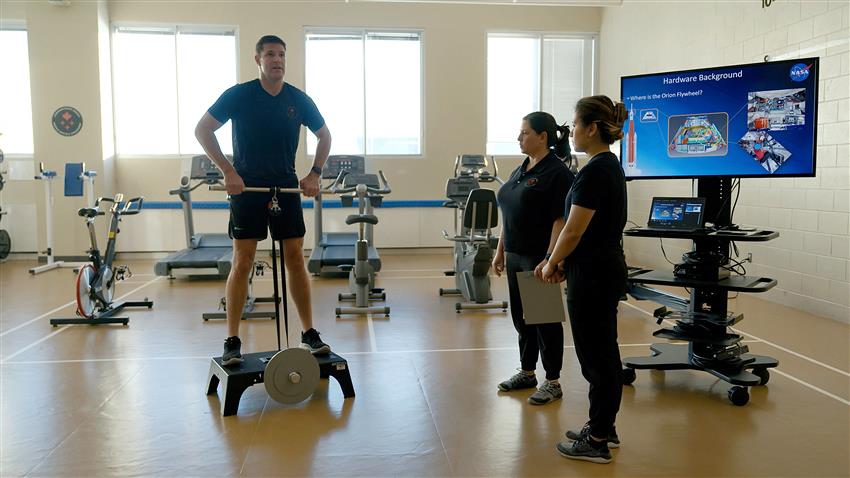Top of page
During the week of , the Canadian Space Agency (CSA) put a flywheel exercise device through its very first test in a microgravity environment. A flywheel device will be used by the astronauts of the early Artemis missions (at least through Artemis V) to stay in shape. It hitched a ride aboard the National Research Council’s Falcon 20 airplane during a parabolic flight campaign at the Montreal Metropolitan Airport in Longueuil, Quebec. Parabolic flights are a cost-effective way to test technologies and conduct science experiments in microgravity using airplanes (affectionately referred to as “vomit comets”).
Flywheels have been used to exercise for a while now. They were invented in the 1990s to counteract muscle and bone loss caused by microgravity, but never flew to space. In recent years, they have been used in the realm of human performance and rehabilitation. NASA has designed a flywheel for the Orion spacecraft. It had to meet several specifications (e.g. vibration, acoustic), but mostly had to be small, light and use no power. The device will also serve as a step to help crewmembers get in and out through the side hatch.
NASA is doing extensive engineering and life cycle testing on the device to make sure that all the technical specifications are met. They are also planning to do a more detailed study on the effectiveness of flywheel training.

CSA astronaut Jeremy Hansen performs deadlift high pulls using a commercially available flywheel at the CSA‘s headquarters. Natalie Hirsch, Project Manager, Operational Space Medicine (left) and Yuwen Zheng, Research Assistant from Canadian Forces Morale and Welfare Services, oversee the training session. Credit: CSA
In preparation to support the CSA astronauts assigned to the Artemis II mission, Jeremy Hansen and his backup Jenni Gibbons, the CSA is focusing on developing, testing and optimizing exercise protocols for the flywheel.
In collaboration with NASA, the CSA team has replicated the specifications of the Orion flywheel (dimensions, gears, resistance levels) on a commercially available flywheel device and used it to trial various exercise protocols.
Testing on Earth, in the sky and in space
To find answers and test training protocols, the CSA, in collaboration with Canadian Forces Morale and Welfare Services (CFMWS), enlisted members of the Canadian Armed Forces and personnel from CFMWS and the CSA for multi-day testing campaigns on Earth.
A total of 30 participants performed 10 sessions each (two familiarization sessions and eight training sessions). Body composition data as well as data related to the sessions such as cadence, resistance, reps, sets, power and force were measured. The main objective was to evaluate if it was feasible to train on the flywheel for 30 minutes alternating strength and cardiovascular training, using the four approved exercises. After the familiarization sessions, the participants followed similar protocols that the CSA exercise specialists are considering for in-flight exercise.

CSA employees Alice Carvalho (left, doing a deadlift) and Frédérique Charron (right, doing a squat) during testing sessions of the flywheel at the CSA‘s headquarters. Credit: CSA
The next step was to perform similar tests in a microgravity environment to better replicate the conditions in which the astronauts will exercise.
A CSA team geared up to test the device on a series of parabolic flights. In total, four people tested exercises on six parabolic flights.
The Artemis II crewmembers will further test the flywheel in the real space environment during their mission, the first crewed test flight of the Artemis program.
There is still much to learn about using a flywheel for exercise in space, such as:
- Is training with solely a flywheel device for 30 minutes feasible?
- Is training with a flywheel in space feasible given the constraints (space available, size of the device, time available, three resistance gears, etc.)?
- What is the most effective exercise program (strength and cardiovascular training) that can be done aboard Orion?
- Will results (total volume lifted, force/power produced, heart rate) be the same on Earth and in microgravity?
Under the Artemis Accords, the CSA is collaborating with the international partners to support health and optimize performance of astronauts.

Location of the flywheel inside Orion. The flywheel will also be used by crewmembers to get in and out of the capsule through its side hatch. Credit: NASA
About the flywheel
- Approximately 13.6 kg and slightly smaller than a carry-on suitcase.
- On the International Space Station, astronauts have access to several exercise machines that collectively weigh more than 1800 kg and occupy about 24 cubic metres.
- The system includes an exercise bar, foot restraints, squat harness, USB cable and heart rate monitor.
- It will allow the astronauts to row for aerobic exercise and to perform harness squats, deadlifts, deadlift high pulls bent over rows for resistance.
- It doesn’t require power (except for data collection).
Explore further
- Date modified: